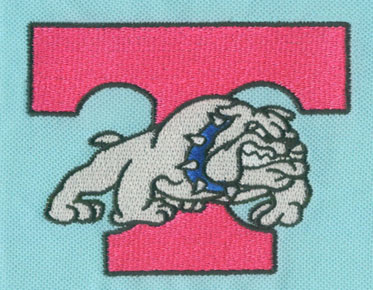About Small Lettering in Embroidering Digitizing
Do you find it difficult to digitize embroidery small letters?
Effective and efficient tools, needles and thread need to be used. You also
need to consider other factors such as stabilizing the fabric, color transfer
and keeping a steady hand.
The fabric
Needle
Thread
Lettering style
Underlay
Take care when you're embroidering super small letters. The small font in the design, Ontario County, New York, is only 3.6 mm high. This won't work if it's uppercase and lowercase. It is best to keep the smaller letters in all caps. When you're embroidering letters that small, it's also helpful to use regular block letters instead of serif letters.
Getting small print to your liking
usually means making adjustments to allow for your fabric type and the size and
style of font your client requests. Many times their demands are unacceptable
for embroidery. They're used to seeing their logos in font sets, usually ink or
screen printing ink, which doesn't always work with needle and thread. It's not
uncommon for clients to ask for an unreasonable amount of all letters on one
line.
With small print, you have to strike a balance between fabric, needle, thread, and lettering size and style. You can't make the letters so small that the stitches you're creating will overlap each other. This can cause holes and broken threads in the fabric. Your stitch length must be at least 1 mm in order to sew without creating holes.
Another key factor in sewing small
print is padding
Instead of using pads under lowercase letters, many people use heavy density. This will also create holes in your fabric and nest. With the padding added, you can lighten the density, so, there isn't as much stitch penetration in the same spot.
The average embroiderer uses either
75/11 or 80/12 stitches. Both needles are too large if you are sewing small
print. The 75/11 needle is .75mm in diameter. If you are creating a stitch length
of 1mm, the stitch penetration points are only .25mm apart. There is very
little fabric left between the stitches. Letters smaller than 6mm should
technically not be sewn with any needle larger than 70/10 stitches and letters
4mm or smaller should be sewn with 65/9 stitches. In the case of knitted
fabrics, ballpoint needles must be used. If it is woven, you will use a sharp
needle.
It is best to keep lowercase letters
at 6mm if possible
This is a quarter inch. On numerous company logos that are required today, it is necessary to go below a quarter of an inch, many times as low as 4mm. The lowercase letters of the font are measured in 4mm increments and measure approximately 3mm, depending on the font. That's only an eighth of an inch. It's very small. Lowercase letters such as o or a or b must have a center opening of at least 1mm. If not, you will cut a hole in the fabric as you sew. This is why it is so important to use a smaller needle. The smaller your needle, the sharper and cleaner your letters will look.
Fabric is another key element of
balance versus small print
We have many styles and types of
knitted and woven fabrics. The more stable the fabric, the easier it is to sew
small print. Knits (like Pixar) are stiff and small print can create many
problems. With these knits, the stitches want to sink into the fabric, you have
to use the padding to control this, but not create too many stitches.


